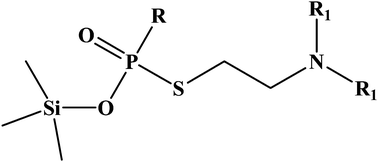Gas chromatography-mass spectrometric analysis of trimethylsilyl derivatives of toxic hydrolyzed products of nerve agent VX and its analogues for verification of Chemical Weapons Convention†
Abstract
The formation of

* Corresponding authors
a
Vertox Laboratory, Defence Research and Development Establishment, Jhansi Road, Gwalior, India
E-mail:
dkdubey@rediffmail.com
Fax: +91-751-2341148
Tel: +91-751-2233488
The formation of

 Please wait while we load your content...
Something went wrong. Try again?
Please wait while we load your content...
Something went wrong. Try again?
D. Pardasani, A. Purohit, A. Mazumder and D. K. Dubey, Anal. Methods, 2010, 2, 661 DOI: 10.1039/C0AY00089B
To request permission to reproduce material from this article, please go to the Copyright Clearance Center request page.
If you are an author contributing to an RSC publication, you do not need to request permission provided correct acknowledgement is given.
If you are the author of this article, you do not need to request permission to reproduce figures and diagrams provided correct acknowledgement is given. If you want to reproduce the whole article in a third-party publication (excluding your thesis/dissertation for which permission is not required) please go to the Copyright Clearance Center request page.
Read more about how to correctly acknowledge RSC content.
 Fetching data from CrossRef.
Fetching data from CrossRef.
This may take some time to load.
Loading related content
